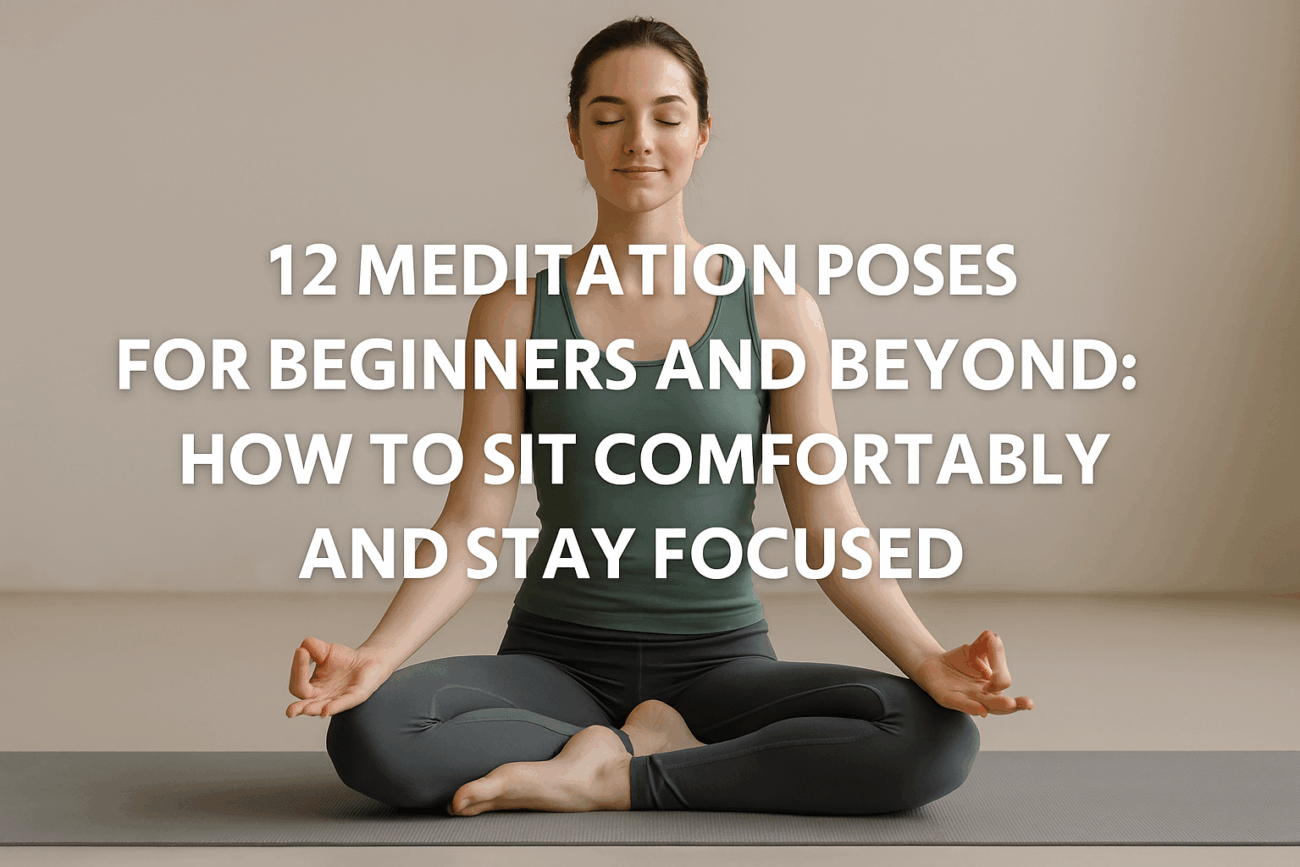Introduction: Why Your Meditation Pose Matters
Ever tried to meditate but couldn’t focus because your back hurt or your legs fell asleep? You’re not alone. Many people give up on meditation—not because it doesn’t work—but because their sitting position is uncomfortable.
Here’s the good news: you don’t have to sit like a pretzel to meditate well. In fact, how you sit affects how easily you can focus, breathe, and relax.
This guide will walk you through 12 comfortable and effective meditation poses — from supported chair meditation posture to cross-legged and kneeling options. You’ll learn how to sit during meditation with proper spine alignment and discover what truly makes a pose sustainable for you.
Whether you’re a beginner or working to deepen your practice, these meditation sitting positions are easy to understand and even easier to try. Let’s explore them together.
1. Why Meditation Posture Matters More Than You Think
Your posture is the foundation of your practice. Proper alignment helps you:
- Breathe deeper
- Stay focused longer
- Avoid back, hip, or knee pain
When you sit in one of the best meditation postures, your body relaxes and your mind can follow. That’s why learning how to sit properly is just as important as learning how to breathe mindfully.
2. Easy Meditation Poses for Beginners (No Flexibility Needed)
If you’re just starting, try these beginner-friendly seated meditation positions:
- Easy Pose (Sukhasana): Sit cross-legged with support under your hips.
- Chair Meditation Posture: Sit upright in a chair, feet flat on the ground.
- Wall Support: Sit with your back against the wall, legs gently crossed or extended.
These are all comfortable meditation poses that help you focus without stressing your joints.
3. Classic Seated Meditation Poses for Flexibility and Stability
If you’re more flexible, these traditional cross-legged meditation poses offer grounding and focus:
- Burmese Pose: Cross-legged with both feet flat on the floor.
- Half Lotus: One foot on the opposite thigh, the other under your leg.
- Full Lotus: Both feet on opposite thighs—only for those with open hips and healthy knees.
These meditation poses for flexibility offer balance and strength, but go slow and use props as needed.
4. Kneeling Meditation Poses for Better Back Support
Kneeling improves spine alignment in meditation and reduces pressure on hips:
- Seiza Pose: Kneel using a cushion or meditation bench.
- Thunderbolt (Vajrasana): Sit on your heels; best for short practices.
- Hero’s Pose (Virasana): Knees apart, sitting between feet with support.
These options are helpful if cross-legged poses are uncomfortable.
5. Chair Meditation Posture: Comfort + Support
Chair meditation posture is one of the best meditation postures for people with back pain or mobility issues:
- Sit upright, feet flat on the floor
- Knees in line with hips
- Use a cushion behind your back if needed
This setup supports spine alignment in meditation and keeps your body relaxed yet alert.
6. Lying Down and Standing Meditation Poses
Sometimes sitting isn’t possible. In those cases, consider these:
- Corpse Pose (Savasana): Lie flat on your back with arms at your sides.
- Mountain Pose (Tadasana): Stand tall, feet grounded, arms relaxed by your sides.
These yoga poses for meditation help you stay mindful in different postures, especially during body scans or mindful walking.
7. Tips to Make Any Meditation Pose More Comfortable
Make any position better with these tricks:
- Use cushions or folded blankets to lift your hips
- Align your spine and keep your neck relaxed
- Let your shoulders drop away from your ears
- Rest your hands gently in your lap or on your knees
No matter the pose, comfort helps create focus.
8. Common Mistakes (And How to Fix Them)
Here are a few posture pitfalls:
- Slouching: Use props to lift your body and sit taller
- Shoulder tension: Shake them out and relax
- Overstretching: Never force your legs into tough positions
- Ignoring pain: Adjust or switch poses to avoid long-term discomfort
Always listen to your body.
9. How to Choose the Best Pose for You
Your best pose is the one that lets you stay still, breathe deeply, and remain alert without strain.
Ask yourself:
- Can I sit here for 5–10 minutes without pain?
- Is my spine upright and relaxed?
- Am I breathing fully and calmly?
Try different meditation sitting positions until you find the one that suits your body best.
Conclusion: Sit Your Way to Stillness
Your journey doesn’t require the most advanced pose—it just requires the one that supports you.
Whether it’s a chair, cushion, or cross-legged meditation pose, comfort builds consistency. And consistency brings clarity, focus, and peace.
Try a new pose today. Adjust it as needed. And trust that your stillness will grow, one breath at a time.
Read more about Which Type of Meditation Is Right for Me?
Meditation for Better Sleep
Meditation for Overthinkers
Learning how to meditate
Cleveland Clinic – Best Meditation Positions
Yoga Journal – Seated Poses Directory

